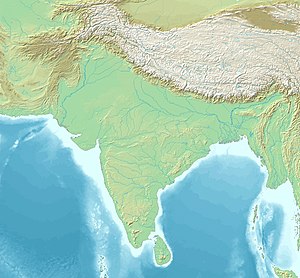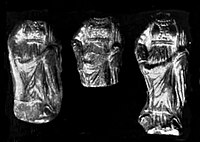
33°48′21″N 75°05′51″E / 33.805833°N 75.097500°E / 33.805833; 75.097500 Semthan, also Semithan is a village 1 km north of Bijbehara in the Anantnag district of the Kashmir Valley in Jammu and Kashmir, India. It has an archaeological site, the ancient site of Chakradhar where cultural sequences were stratified, from the Neolithic to the Indo-Greek and Kushan periods.
Excavations
The site was excavated during several seasons from 1977 to 1981. Upon excavation, the site revealed several occupation layers:
Period 1: pre-NBPW (700-500 BCE)
Period 2: NBPW (500-200 BCE)
Period 3: Indo-Greek (200-0 BCE)
Period 4: Kushan Empire, Huna Kingdom (1st-5th century CE)
Period 5: Hindu (5th-13th century CE)
Period 6: Late Medieval, post 13th century
Pottery wares were found in Level 3, as well as a seal with an Indo-Greek deity, and Indo-Greek coins. A large number of terracotta figurines were also found in Level 4.
Artefacts
See also: Indo-Greek artSemthan was at one point a Greek settlement. Many figurines in the Hellenistic style were found during the excavations. The female figurines are fully dressed, with the left leg slightly bent, and wear the Greek chiton and himation, and the Hellenistic styles of Bactria are probably the ultimate source of these designs. It is thought that the Indo-Greeks introduced their artistic styles into the area as they moved eastward from the area of Gandhara into South Kashmir. The stratigraphy does not permit a precise dating of these statuettes, and the date has been broadly defined as probably pertaining to the period from the 2nd half of the 1st century BCE to the 1st or 2nd century CE, in effect covering the end of the Indo-Greek period to the early Kushan period.
Such Hellenistic draped figurines have not been found at Taxila or Charsadda, although they are known to have been Indo-Greek cities, but probably this is mainly because excavations to Greek levels have been very limited: in Sirkap, only one eight of the excavations were made down to the Indo-Greek and early Saka levels, and only in an area far removed from the center of the ancient city, where few finds could be expected.
-
 Terracotta statuette in Chiton and Himation, Semthan
Terracotta statuette in Chiton and Himation, Semthan
-
 Male Hellenistic dress, Semthan
Male Hellenistic dress, Semthan
-
 Semthan, female Hellenistic dresses
Semthan, female Hellenistic dresses
-
 Figure with helmet, Semthan
Figure with helmet, Semthan
-
 Indo-Greek coin of Lysias and other coinage, Semthan
Indo-Greek coin of Lysias and other coinage, Semthan
-
 Indo-Greek coin of Lysias (130–120 BCE), Indian square standard, of the type found at Semthan
Indo-Greek coin of Lysias (130–120 BCE), Indian square standard, of the type found at Semthan
-
 Semthan, sealing with Indo-Greek deity.
Semthan, sealing with Indo-Greek deity.
References
- ^ Siudmak, John (2013). The Hindu-Buddhist Sculpture of Ancient Kashmir and its Influences. BRILL. p. 32–36. ISBN 978-90-04-24832-8.
- ^ Indian Archaeology 1980-81 A Review (PDF). Archaeological Survey of India. 1981. pp. 21–23.
- Jamwal, Suman (1994). "Commercial Contacts Between Kashmir and Rome". Annals of the Bhandarkar Oriental Research Institute. 75 (1/4): 202. ISSN 0378-1143. JSTOR 41694416.
- Siudmak, John (2013). The Hindu-Buddhist Sculpture of Ancient Kashmir and its Influences. BRILL. p. 43. ISBN 978-90-04-24832-8.
- Kaw, Mushtaq A. (2010). "Central Asian Contribution to Kashmir's Tradition of Religio-Cultural Pluralism". Central Asiatic Journal. 54 (2): 245. ISSN 0008-9192. JSTOR 41928559.
- Siudmak, John (2013). The Hindu-Buddhist Sculpture of Ancient Kashmir and its Influences. BRILL. p. 33. ISBN 978-90-04-24832-8.
- Siudmak, John (2013). The Hindu-Buddhist Sculpture of Ancient Kashmir and its Influences. BRILL. p. xiii. ISBN 978-90-04-24832-8.
- Siudmak, John (2013). The Hindu-Buddhist Sculpture of Ancient Kashmir and its Influences. BRILL. pp. 39–43. ISBN 978-90-04-24832-8.